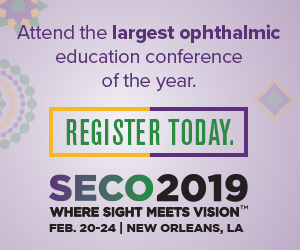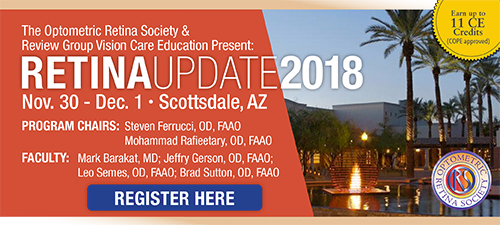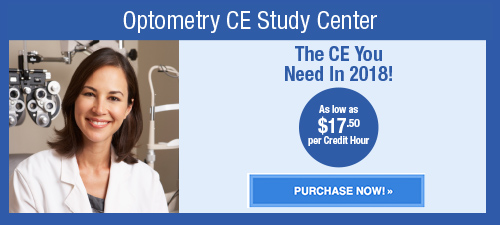
A
weekly e-journal by Art Epstein, OD, FAAO
Off the Cuff: Our Needless and Damaging Organizational Divide
A few years ago, when 1-800 Contacts made the mistake of choosing Arizona as a test ground for contact lens deregulation, it encountered the Arizona Optometric Association, a well-organized, determined and unrelenting force for patient safety. The effort, led by our indefatigable legislative chair, Annette Hanian, and super-effective lobbying team, led by Don Isaacson, fended off 1-800’s attack at significant cost to them and with no tangible gain.
|
|||||
|
|||
| Severe Dry Eye with Combined Mechanisms is Involved in the Ocular Sequelae of SJS/TEN at the Chronic Stage | ||||
Stevens-Johnson syndrome (SJS), and its more severe variant, toxic epidermal necrolysis (TEN), are life-threatening diseases of the skin and mucous membranes. After the acute-stage damage subsides, serious visual impairment and severe dry eye remains as ocular sequelae.
At the acute stage, ocular complications occur in 77% of SJS/TEN patients, authors wrote. In cases with pseudomembranous formation and/or epithelial defects, the risk of ocular sequelae increases, they added. Among 13 slit-lamp microscopy images that authors obtained of SJS/TEN patients at the chronic stage, the loss of corneal epithelial stem cells and severe meibomian gland involvement were found to be the most common disorders. Severe dry eye in SJS includes three important mechanisms: (1) aqueous tear deficiency, (2) decreased wettability of corneal surface and (3) increased evaporation. Dry eye severity in SJS patients is often underestimated when the meniscus is first observed, as the punctum is closed due to scarring or surgery, authors wrote. In SJS patients with severe dry eye, the dryness results in immense eye pain and unstable tear film related to dry eye result in a change/loss of vision. For the treatment of dry eye in SJS, authors wrote that it is important to suppress chronic inflammation on the ocular surface, and 2% rebamipide ophthalmic solution reportedly helps to obtain ocular surface stabilization. They added that scleral contact lenses, as well as the newly developed limbal-rigid contact lenses, improve the patients' visual acuity and reduce symptoms related to severe dry eye. Authors concluded that further studies and new therapeutic methods are needed to more effectively treat dry eye in patients afflicted with SJS/TEN. |
||||
SOURCE: Sotozono C, Ueta M, Yokoi N. Severe dry eye with combined mechanisms is involved in the ocular sequelae of SJS/TEN at the chronic stage. Invest Ophthalmol Vis Sci. 2018;59(14):DES80-DES86. |
||||
|
|||
| Sleep Disorders are a Prevalent and Serious Comorbidity in Dry Eye | ||||
Sleep is an essential life habit and closely associated with lifespan, diabetes, hypertension and mental health. Sleep disorders are a prominent, but overlooked problem in patients with dry eye disease (DED). They are characterized by a poor sleep index, short sleep duration, long sleep latency and poor subjective sleep. DED and sleep disorders are more prevalent in women than men, authors wrote. Moreover, sleep quality in DED is worse than in other eye diseases, including glaucoma, retinal diseases, cataract, and allergic and chronic conjunctivitis. Authors reviewed the literature for studies investigating sleep and health, eyes and sleep, and DED and sleep, in terms of systemic and eye health, especially in women.
Two studies reported that approximately half of patients with DED suffer from poor sleep. The severity of mood disorders, including anxiety and depression, is correlated strongly with sleep disorders in DED, and the symptoms and signs of DED, especially pain, also are correlated with sleep quality. Sleep disorders are documented in primary Sjögren's syndrome, and an association with sleep apnea and depression is suggested. Primary Sjögren's syndrome includes arthritis and other rheumatic disease causing pain and fatigue; however, how sicca contributes to sleep disorders is not known. Possible explanations for sleep disorders in DED may be depression, pain and eye exposure at night, authors wrote. Reciprocal effects may be expected and consultation-liaison psychiatry is recommended for the management of sleep disorders in DED, they added. Topical medication and lid heating also may be advantageous for sleep quality in DED, they wrote further. |
||||
SOURCE: Ayaki M, Tsubota K, Kawashima M, et al. Sleep disorders are a prevalent and serious comorbidity in dry eye. Invest Ophthalmol Vis Sci. 2018;59(14):DES143-DES150. |
||||
 |
||
| Is Blur Sensitivity Altered in Children with Progressive Myopia? | ||||
School-aged children with progressive myopia show large accommodative lags to blur-only cue, suggestive of a large depth of focus (DOF). While DOF measures are lacking in this age group, their blur detection and discrimination capacities appear to be similar to their non-myopic peers. Accordingly, the current study quantified DOF and blur detection ability in progressive myopic children showing large accommodative lags compared with their non-myopic peers and adults. Blur sensitivity measures were taken from 12 children (8 to 13 years of age, six myopes and six emmetropes) and six adults (20 to 35 years of age). DOF was quantified using step changes in the lens-induced defocus, while the subjects viewed a high-contrast target through a Badal lens at either 2D or 4D demand. Blur detection thresholds (BDT) were tested using a similar high contrast target in a 2-alternate forced-choice paradigm (2AFC) at both the demands.
In addition to the large accommodative lags, micro fluctuations and DOF were significantly larger in myopic children compared with the other groups. However, BDTs were similar across the three groups. When limited to blur cues, the findings of a large DOF coupled with large response lags suggested that myopes were less sensitive to retinal defocus, the researchers wrote. However, in agreement with a previous study, they determined that refractive error had no influence on BDTs, suggesting that the reduced sensitivity to the defocus in a myopic eye appears to be compensated by some form of an adjustment in the higher visual processes to preserve the subjective percept even with a poor retinal image quality. |
||||
SOURCE: Labhishetty V, Chakraborty A, Bobier WR. Is blur sensitivity altered in children with progressive myopia? Vision Res. 2018 Nov 22. [Epub ahead of print] |
||||
| News & Notes | ||||||||||||||||||||||
CMS Issues Permanent J Code for Avedro's Photrexa Drug Formulations
|
||||||||||||||||||||||
| Academy 2018 San Antonio Attendance Shatters All Previous Meeting Records Academy 2018 San Antonio (Nov. 7-10) was the largest meeting in the Academy’s history, with a total of 7,948 registrants (a 3% increase over 2017), including 4,625 optometrists and vision scientists and 1,168 students. Attendees engaged in high-quality continuing education sessions, experienced new products and technologies in the exhibit hall, and learned the latest in vision research that is advancing the profession. Read more. |
||||||||||||||||||||||
| Envision Announces Dates, Locations for 2019 Conferences on Low Vision For the first time since its inception in 2006, Envision Conference will be split into two events for the upcoming year: Envision Conference East, March 22-23, 2019, at the University of Alabama at Birmingham; and Envision Conference West, Oct. 5-6, 2019, at the College of Optometry at Western University of Health Sciences’ in Pomona, Calif. With both institutions known for their premier programs focused on vision and/or vision related rehabilitation, the format change will expand the reach of Envision Conference. Clinical education and research abstracts involving low vision rehabilitation are currently being accepted for the East and West conferences. Read more. |
||||||||||||||||||||||
|
||||||||||||||||||||||
|
Optometric Physician™ (OP) newsletter is owned and published by Dr. Arthur Epstein. It is distributed by the Review Group, a Division of Jobson Medical Information LLC (JMI), 11 Campus Boulevard, Newtown Square, PA 19073. HOW TO ADVERTISE |






